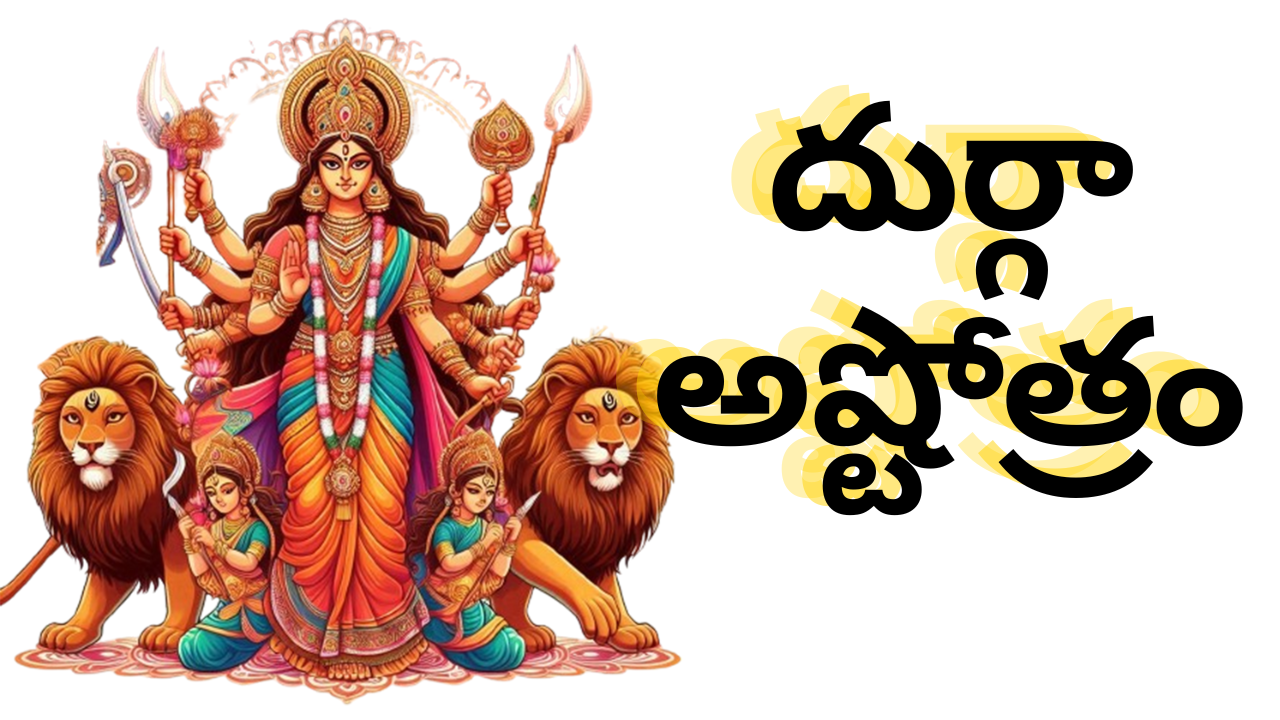Durga Ashtothram in Telugu : The Durga Ashtothram in Telugu is a powerful devotional tool that connects devotees with Goddess Durga through her sacred 108 names. Download the durga ashtothram in telugu pdf Here.
దుర్గా అష్టోత్రం
ఓం దుర్గాయై నమః
ఓం శివాయై నమః
ఓం మహాలక్ష్మ్యై నమః
ఓం మహాగౌర్యై నమః
ఓం చండికాయై నమః
ఓం సర్వజ్ఞాయై నమః
ఓం సర్వాలోకేశాయై నమః
ఓం సర్వకర్మఫలప్రదాయై నమః
ఓం సర్వతీర్ధమయ్యై నమః
ఓం పుణ్యాయై నమః (10)
ఓం దేవయోనయే నమః
ఓం అయోనిజాయై నమః
ఓం భూమిజాయై నమః
ఓం నిర్గుణాయై నమః
ఓం ఆధారశక్త్యై నమః
ఓం అనీశ్వర్యై నమః
ఓం నిర్గుణాయై నమః
ఓం నిరహంకారాయై నమః
ఓం సర్వగర్వ విమర్దిన్యై నమః
ఓం సర్వలోకప్రియాయై నమః (20)
ఓం వాణ్యై నమః
ఓం సర్వవిద్యాధి దేవతాయై నమః
ఓం పార్వత్యై నమః
ఓం దేవమాత్రే నమః
ఓం వనీశాయై నమః
ఓం వింధ్యవాసిన్యై నమః
ఓం తేజోవత్యై నమః
ఓం మహామాత్రే నమః
ఓం కోటిసూర్య సమప్రభాయై నమః
ఓం దేవతాయై నమః (30)
ఓం వహ్నిరూపాయై నమః
ఓం సతేజసే నమః
ఓం వర్ణరూపిణ్యై నమః
ఓం గుణాశ్రయాయై నమః
ఓం గుణమధ్యాయై నమః
ఓం గుణత్రయ వివర్జితాయై నమః
ఓం కర్మజ్ఞానప్రదాయై నమః
ఓం కాంతాయై నమః
ఓం సర్వసంహార కారిణ్యై నమః
ఓం ధర్మజ్ఞానాయై నమః (40)
ఓం ధర్మనిష్ఠాయై నమః
ఓం సర్వకర్మ వివర్జితాయై నమః
ఓం కామాక్ష్యై నమః
ఓం కామసంహర్త్ర్యై నమః
ఓం కామక్రోధ వివర్జితాయై నమః
ఓం శాంకర్యై నమః
ఓం శాంభవ్యై నమః
ఓం శాంతాయై నమః
ఓం చంద్రసుర్యాగ్ని లోచనాయై నమః
ఓం సుజయాయై నమః (50)
ఓం జయభూమిష్ఠాయై నమః
ఓం జాహ్నవ్యై నమః
ఓం జనపూజితాయై నమః
ఓం శాస్త్ర్యై నమః
ఓం శాస్త్రమయ్యై నమః
ఓం నిత్యాయై నమః
ఓం శుభాయై నమః
ఓం చంద్రార్ధమస్తకాయై నమః
ఓం భారత్యై నమః
ఓం భ్రామర్యై నమః (60)
ఓం కల్పాయై నమః
ఓం కరాళ్యై నమః
ఓం కృష్ణ పింగళాయై నమః
ఓం బ్రాహ్మ్యై నమః
ఓం నారాయణ్యై నమః
ఓం రౌద్ర్యై నమః
ఓం చంద్రామృత పరిస్రుతాయై నమః
ఓం జ్యేష్ఠాయై నమః
ఓం ఇందిరాయై నమః
ఓం మహామాయాయై నమః (70)
ఓం జగత్సృష్ట్యధికారిణ్యై నమః
ఓం బ్రహ్మాండకోటి సంస్థానాయై నమః
ఓం కామిన్యై నమః
ఓం కమలాలయాయై నమః
ఓం కాత్యాయన్యై నమః
ఓం కలాతీతాయై నమః
ఓం కాలసంహారకారిణ్యై నమః
ఓం యోగనిష్ఠాయై నమః
ఓం యోగిగమ్యాయై నమః
ఓం యోగిధ్యేయాయై నమః (80)
ఓం తపస్విన్యై నమః
ఓం జ్ఞానరూపాయై నమః
ఓం నిరాకారాయై నమః
ఓం భక్తాభీష్ట ఫలప్రదాయై నమః
ఓం భూతాత్మికాయై నమః
ఓం భూతమాత్రే నమః
ఓం భూతేశ్యై నమః
ఓం భూతధారిణ్యై నమః
ఓం స్వధాయై నమః
ఓం నారీ మధ్యగతాయై నమః (90)
ఓం షడాధారాధి వర్ధిన్యై నమః
ఓం మోహితాంశుభవాయై నమః
ఓం శుభ్రాయై నమః
ఓం సూక్ష్మాయై నమః
ఓం మాత్రాయై నమః
ఓం నిరాలసాయై నమః
ఓం నిమ్నగాయై నమః
ఓం నీలసంకాశాయై నమః
ఓం నిత్యానందాయై నమః
ఓం హరాయై నమః (100)
ఓం పరాయై నమః
ఓం సర్వజ్ఞానప్రదాయై నమః
ఓం అనంతాయై నమః
ఓం సత్యాయై నమః
ఓం దుర్లభరూపిణ్యై నమః
ఓం సరస్వత్యై నమః
ఓం సర్వగతాయై నమః
ఓం సర్వాభీష్టప్రదాయిన్యై నమః (108)
Table of Contents
Durga Ashtothram in Telugu:
Introduction
Durga Ashtothram, or the “108 Names of Goddess Durga,” is a revered devotional hymn dedicated to Goddess Durga, an embodiment of strength, compassion, and protection in Hinduism. This hymn is sung or chanted by devotees to invoke the blessings and protection of the goddess. In Telugu-speaking regions, the Durga Ashtothram holds special significance as it is often recited in the local language, enhancing its accessibility and spiritual connection for devotees.
In this article, we’ll delve into the Durga Ashtothram in Telugu, exploring its significance, benefits, and how to recite it correctly. We’ll also address some frequently asked questions to help you better understand this sacred practice.
Significance of Durga Ashtothram
Durga Ashtothram is a sacred text that enumerates 108 different names of Goddess Durga, each representing a unique aspect of her divine nature. Chanting these names is believed to bring numerous benefits, including spiritual growth, protection from negative forces, and the fulfillment of one’s desires.
Historical and Spiritual Context
Goddess Durga is one of the principal deities in Hinduism, symbolizing the universal mother who protects her devotees from evil and grants them strength and wisdom. The Durga Ashtothram is a form of devotional worship that has been practiced for centuries, rooted in ancient scriptures and traditions.
Benefits of Reciting Durga Ashtothram
- Spiritual Upliftment: Regular recitation helps in personal spiritual growth and deepens one’s connection with the divine.
- Protection from Negativity: It is believed to shield the devotee from negative energies and harmful influences.
- Fulfillment of Wishes: Chanting with devotion is thought to help in achieving personal goals and desires.
- Mental Peace: The practice provides mental peace and stability, reducing stress and anxiety.
How to Recite Durga Ashtothram in Telugu
Reciting Durga Ashtothram requires sincerity and devotion. Here’s a step-by-step guide on how to recite it in Telugu:
Preparation
- Cleanse Yourself: Ensure that you are physically clean and wear clean clothes. This enhances the purity of your practice.
- Create a Sacred Space: Designate a quiet and clean area for recitation. You can place an image or idol of Goddess Durga in this space.
- Gather Materials: Have a copy of the Durga Ashtothram in Telugu, incense sticks, a diya (lamp), and a flower or two for offering.
Recitation Steps
- Start with Invocation: Begin by lighting the diya and incense sticks, and offer a flower to Goddess Durga. Recite a short prayer to invoke her presence.
- Chant the Names: Recite the 108 names of Goddess Durga as listed in the Durga Ashtothram. Each name is a manifestation of the goddess’s power and grace.
- Meditate: After recitation, spend a few moments in meditation, focusing on the goddess and her qualities.
- Conclude: Conclude with a closing prayer, expressing gratitude for the blessings and protection received.
FAQs About Durga Ashtothram in Telugu
What is the Durga Ashtothram?
The Durga Ashtothram is a sacred hymn consisting of 108 names of Goddess Durga, each reflecting a different aspect of her divine nature. It is chanted to seek her blessings and protection.
Why is the Durga Ashtothram recited in Telugu?
Reciting the Durga Ashtothram in Telugu makes the hymn more accessible to Telugu-speaking devotees, allowing them to connect more deeply with the divine names and their meanings.
How often should the Durga Ashtothram be recited?
There is no strict rule regarding the frequency of recitation. Devotees may recite it daily, weekly, or on special occasions, depending on personal devotion and convenience.
Can the Durga Ashtothram be recited by anyone?
Yes, anyone can recite the Durga Ashtothram regardless of age, gender, or background. It is a devotional practice meant to be inclusive and accessible to all.
What are the benefits of reciting the Durga Ashtothram?
Reciting the Durga Ashtothram is believed to provide spiritual upliftment, protection from negativity, fulfillment of desires, and mental peace. It strengthens one’s devotion and connection with Goddess Durga.
Is it necessary to recite all 108 names?
While reciting all 108 names is considered ideal, it is not mandatory. Devotees can start with a few names and gradually increase their practice as they become more comfortable.
Can the Durga Ashtothram be recited silently?
Yes, the Durga Ashtothram can be recited silently or mentally. The important aspect is the devotion and concentration during the recitation.
Where can I find the Durga Ashtothram in Telugu?
The Durga Ashtothram in Telugu can be found in various religious texts, online resources, and local temples. Many websites offer downloadable versions for easy access.
Conclusion
The Durga Ashtothram in Telugu is a powerful devotional tool that connects devotees with Goddess Durga through her sacred 108 names. By reciting these names with devotion, one can experience spiritual growth, protection, and fulfillment. Whether you are a seasoned devotee or new to this practice, incorporating the Durga Ashtothram into your spiritual routine can be a transformative experience. Embrace this sacred hymn with sincerity and allow its divine energy to enrich your life.




